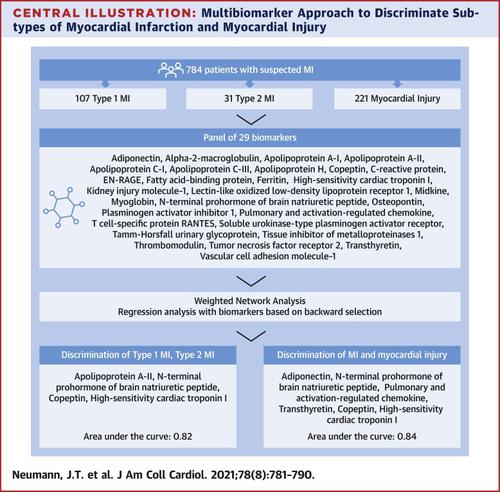Journal of the American College of Cardiology ( IF 21.7 ) Pub Date : 2021-08-16 , DOI: 10.1016/j.jacc.2021.06.027 Johannes T Neumann 1 , Jessica Weimann 2 , Nils A Sörensen 3 , Tau S Hartikainen 2 , Paul M Haller 3 , Jonas Lehmacher 2 , Celine Brocks 2 , Sophia Tenhaeff 2 , Mahir Karakas 3 , Thomas Renné 4 , Stefan Blankenberg 3 , Tanja Zeller 3 , Dirk Westermann 3

|
Background
Discrimination among patients with type 1 myocardial infarction (T1MI), type 2 myocardial infarction (T2MI), and myocardial injury is difficult.
Objectives
The aim of this study was to investigate the discriminative value of a 29-biomarker panel in an emergency department setting.
Methods
Patients presenting with suspected myocardial infarction (MI) were recruited. The final diagnosis in all patients was adjudicated on the basis of the fourth universal definition of MI. A panel of 29 biomarkers was measured, and multivariable logistic regression analysis was used to evaluate the associations of these biomarkers with the diagnosis of MI or myocardial injury. Biomarkers were chosen using backward selection. The model was internally validated using bootstrapping.
Results
Overall, 748 patients were recruited (median age 64 years), of whom 138 had MI (107 T1MI and 31 T2MI) and 221 had myocardial injury. In the multivariable model, 4 biomarkers (apolipoprotein A-II, N-terminal prohormone of brain natriuretic peptide, copeptin, and high-sensitivity cardiac troponin I) remained significant discriminators between T1MI and T2MI. Internal validation of the model showed an area under the curve of 0.82. For discrimination between MI and myocardial injury, 6 biomarkers (adiponectin, N-terminal prohormone of brain natriuretic peptide, pulmonary and activation-regulated chemokine, transthyretin, copeptin, and high-sensitivity troponin I) were selected. Internal validation showed an area under the curve of 0.84.
Conclusions
Among 29 biomarkers, 7 were identified to be the most relevant discriminators between subtypes of MI or myocardial injury. Regression models based on these biomarkers allowed good discrimination. (Biomarkers in Acute Cardiac Care [BACC]; NCT02355457)
中文翻译:

区分心肌梗死和损伤类型的生物标志物模型
背景
很难区分 1 型心肌梗死 (T1MI)、2 型心肌梗死 (T2MI) 和心肌损伤患者。
目标
本研究的目的是调查 29 个生物标志物面板在急诊科环境中的鉴别价值。
方法
招募了疑似心肌梗死 (MI) 的患者。所有患者的最终诊断均基于 MI 的第四个通用定义。测量了一组 29 个生物标志物,并使用多变量逻辑回归分析来评估这些生物标志物与 MI 或心肌损伤诊断的关联。使用反向选择选择生物标志物。该模型使用自举进行了内部验证。
结果
总共招募了 748 名患者(中位年龄 64 岁),其中 138 名患有 MI(107 名 T1MI 和 31 名 T2MI),221 名患有心肌损伤。在多变量模型中,4 个生物标志物(载脂蛋白 A-II、脑钠肽 N 端激素原、和肽素和高敏心肌肌钙蛋白 I)仍然是 T1MI 和 T2MI 之间的重要区分因素。模型的内部验证显示曲线下面积为 0.82。为了区分 MI 和心肌损伤,选择了 6 个生物标志物(脂联素、脑钠肽 N 端激素原、肺和活化调节趋化因子、甲状腺素运载蛋白、和肽素和高敏肌钙蛋白 I)。内部验证显示曲线下面积为 0.84。
结论
在 29 种生物标志物中,有 7 种被确定为 MI 或心肌损伤亚型之间最相关的鉴别器。基于这些生物标志物的回归模型允许很好的区分。(急性心脏护理中的生物标志物 [BACC];NCT02355457)









































 京公网安备 11010802027423号
京公网安备 11010802027423号